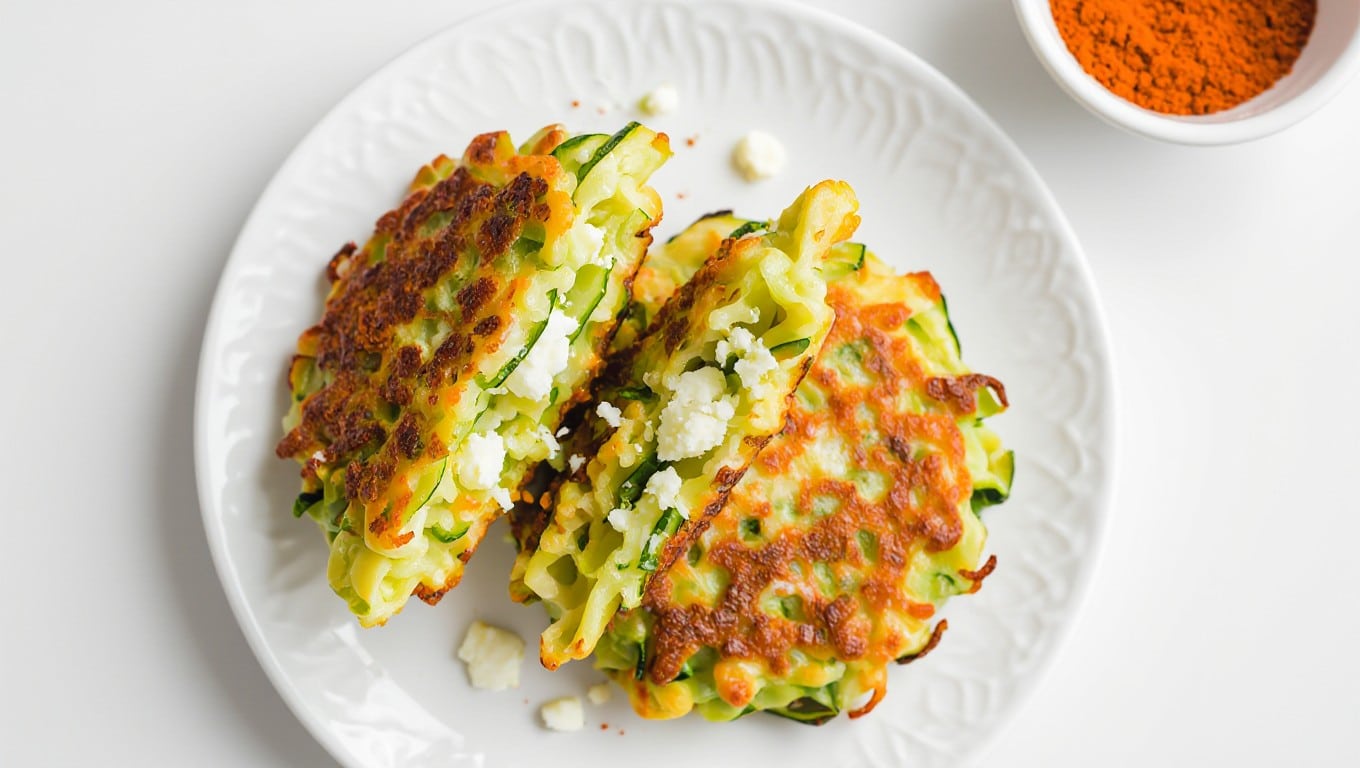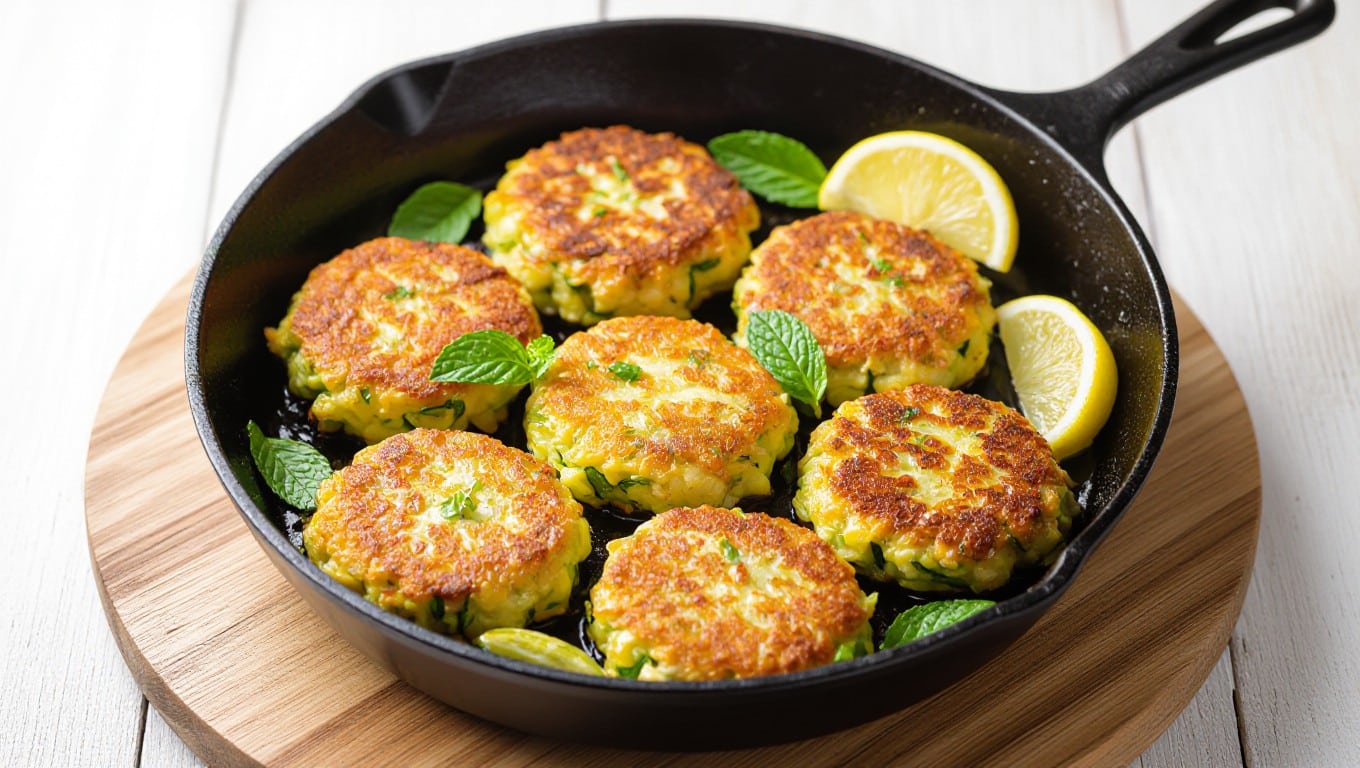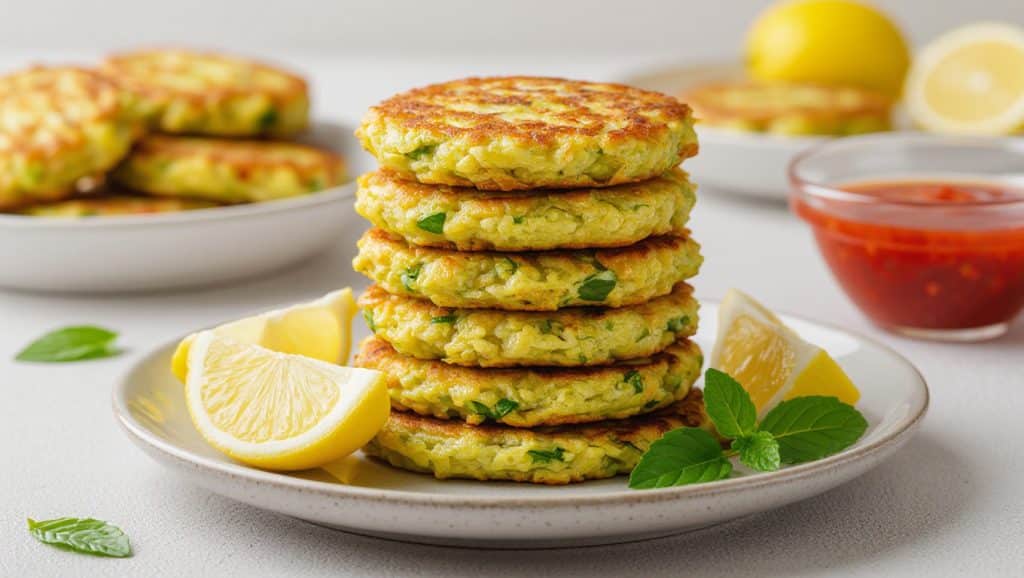If you’re searching for a mouthwatering vegetarian dish, the Jamie Oliver Feta Fritters Recipe is a fantastic choice. These fritters are not only flavorful, but they also provide an excellent means to integrate fresh, healthy ingredients into your diet.
The combination of courgettes and feta cheese delivers a delightful taste experience. They are perfect for any meal, whether it’s a casual lunch or a special gathering.
To create these scrumptious fritters, start by grating the courgettes and combining them with crumbled feta, a sprinkle of sea salt and black pepper, and a handful of fresh herbs like dill and parsley. For an added crunch, consider mixing in some sesame seeds.
After beating an egg, mix it with the vegetable blend for enhanced binding. Then, heat some oil in a frying pan and drop spoonfuls of the mixture into the hot oil, frying until they reach a golden, crispy perfection.
Serve these delightful fritters alongside a vibrant rainbow salad with sesame feta. Incorporate ingredients such as carrot, red onion, and beetroot for a colorful and nutritious dish. This salad with sesame feta fritters is a quick and healthy lunch idea, suitable for both children and adults.
You can easily repurpose any leftover fritters for a satisfying snack, ensuring that nothing goes to waste! With this healthy lunch idea, you can impress your family and friends with a medley of flavors in every bite.
The recipe yields a generous amount, allowing you to share or keep some in the fridge for later enjoyment. These green veggie fritters not only satisfy your taste buds but also make a great addition to your collection of vegetable recipes.
Crispy Courgette & Feta Fritters
Prep: 10 min | Cook: 10 min | Serves: 4
Ingredients: grated courgettes, crumbled feta, plain flour, egg, lemon zest, red chilli, mint, Parmesan, oregano
Method:
- Grate courgettes, squeeze out excess moisture.
- Mix with flour, egg, lemon zest, chilli, mint, Parmesan, oregano and seasonings.
- Fold in crumbled feta.
- Heat oil, spoon fritters, flatten and fry ~2–3 min each side till golden.
- Serve hot with lemon wedges and sweet-chilli sauce.
Over the years, jamie oliver courgette and feta fritters have become a beloved dish thanks to their vibrant flavors and satisfying crunch. You’ll learn how to transform fresh courgettes by grating, salting, and draining them to remove excess moisture — a key step to avoid soggy fritters. By layering zesty lemon, fragrant mint, and creamy feta, you create a dish bursting with flavor. Whether you bind your fritters with flour or chickpea flour, pan-frying or air-frying until golden brings the perfect texture. This guide helps you master a versatile snack or starter you’ll want to serve again and again.
The Art of Grating: Perfecting Your Courgette
Grating courgette properly sets the foundation for your fritters’ texture and flavor balance. Getting the size and moisture right ensures your fritters hold together without becoming soggy. You’ll want to grate the courgette finely enough to blend with feta and mint, yet leave some body to create those satisfying crispy edges when fried. Salting the grated courgette draws out excess water, preventing watery batter, and brings out a subtle sweetness. Layering these steps thoughtfully reflects Jamie Oliver’s flavor philosophy and elevates your fritters from basic to brilliantly balanced.
Selecting Fresh Courgettes for Optimal Flavor
Choosing firm, medium-sized courgettes with glossy skin guarantees freshness and a milder, sweeter flavor. Younger courgettes tend to be less seedy and have a tender texture which works best in fritters. Avoid overly large or limp courgettes since they’re typically waterlogged, leading to soggy batter. If possible, select organic or locally sourced courgettes for a more vibrant taste, ensuring your fritters carry that garden-fresh punch reminiscent of Jamie Oliver’s fresh ingredient ethos.
Mastering the Grating Technique for Texture
Grate your courgette using the medium holes of a box grater or a food processor fitted with a medium grating blade for a balanced texture. Very fine shreds risk turning mushy during cooking, while very coarse pieces might not bind well with the feta and flour, compromising the fritter’s structure. The goal is to create strands that hold moisture without collapsing, so the feta and lemon zest can infuse the fritters with bursts of flavor and maintain that golden crust once pan-fried or air-fried.

Salting with Purpose: Enhancing Flavor and Reducing Moisture
Salting courgettes plays a key role in both flavor development and texture control for your fritters. By drawing out excess water, the courgettes become less soggy, allowing the fritters to crisp beautifully when pan-fried or air-fried. Additionally, salting intensifies the natural sweetness while balancing the tang of lemon zest and saltiness of feta, layering your fritters with complexity inspired by Jamie Oliver’s methodology. Let the grated courgette rest for 10 to 15 minutes after salting, then press firmly to release moisture, ensuring a firm fritter base that binds well with chickpea or regular flour.
The Benefits of Salting Courgettes
Salting your grated courgette helps you remove up to 50% of its water content, preventing watery, fragile fritters. This simple step enhances texture by concentrating flavors and improving the browning effect during cooking. You’ll notice how the natural sugars become more pronounced, complementing the sharpness of crumbled feta and fresh mint. The salt also gently softens the courgette, making it easier to mix evenly with flour and eggs or chickpea flour for a consistent, reliable batter every time.
Techniques for Proper Draining
After salting, squeezing out moisture is imperative. Use a clean kitchen towel, cheesecloth, or even a fine mesh sieve to press out water thoroughly. Wrapping the courgette in the towel and twisting tightly can remove more liquid than straining alone. This reduces the risk of soggy fritters and helps your batter bind well with the flour. Proper draining ensures your fritters are crisp outside with a moist, tender interior, perfect for both stove and air-fryer cooking.
Expanding on these techniques, you might try placing the wrapped courgette under a heavy object for a few minutes to maximize liquid extraction, especially if your courgette is particularly juicy. Some chefs recommend multiple rounds of squeezing for the best results. This process is vital because even a small amount of retained moisture can cause your fritters to fail in setting properly, affecting crispness and cooking time. Using these simple but effective steps, your fritters will hold together reliably, creating that sought-after golden crust Jamie Oliver champions.
Flavor Fusion: The Magic of Feta, Mint, and Lemon Zest
The trio of crumbled feta, fresh mint, and zesty lemon peel transforms simple courgette fritters into a vibrant feast of layered flavors. The salty tang of feta contrasts beautifully with the cooling brightness of mint, while lemon zest awakens the palate, cutting through the fritters’ subtle sweetness. This balancing act inspired by Jamie Oliver’s flavor layering technique ensures every bite delivers complexity without overpowering the courgette’s mild earthiness. You’ll find that this combination not only elevates the taste but also adds appealing textures and aromas that make your fritters irresistibly fresh and satisfying.
Choosing the Right Feta for Intensity
Your choice of feta dramatically impacts the overall flavor intensity of the fritters. Traditional Greek feta, aged and brined, offers a bold, tangy punch that stands up well to the courgette’s delicate profile, pushing the savoriness forward. For a milder touch, opt for a sheep-goat blend with a creamier texture, which melts gently into the batter. Selecting authentic, high-quality feta with balanced saltiness will prevent overpowering the other ingredients while enhancing your fritters’ depth and character.
The Role of Fresh Herbs and Citrus in Brightening Dishes
Incorporating fresh mint and lemon zest into your fritter mix introduces lively, aromatic notes that awaken every mouthful. Mint provides a cool, refreshing contrast, adding layers beyond simple seasoning, while lemon zest’s vital oils bring sharpness and a subtle bitterness that heightens the dish’s complexity. This clever addition prevents the fritters from feeling heavy, making them perfect when paired with creamy yogurt dip or crisp salads. By focusing on bright, fresh ingredients, you’re enhancing both flavor and balance.

Binding and Frying: Making Fritters that Flawlessly Crisp
Achieving that perfect crisp on your courgette and feta fritters hinges on the right balance of binder and frying technique. After mixing the salted, drained courgette with crumbled feta, fresh mint, and lemon zest, you’ll add a flour-based binder to hold everything together. Whether you choose all-purpose or chickpea flour, the batter needs to be loose enough to spread but firm enough to hold shape. Heat your pan with a good amount of oil to create a sizzling surface, then fry in small batches until each fritter turns a beautiful golden brown with a crisp shell that contrasts the tender, savory interior.
Flour vs. Chickpea Flour: Picking Your Binder
All-purpose flour provides a neutral, familiar texture, yielding light and fluffy fritters. Chickpea flour, on the other hand, adds a nuttier depth and is naturally gluten-free, making it perfect for those avoiding gluten. Chickpea flour also binds exceptionally well due to its higher protein content, helping the fritters hold their shape without excess flour. Use about 3 tablespoons of flour or chickpea flour per two medium courgettes, adjusting slightly if the mixture feels too wet or dry, to find your ideal consistency.
Techniques for Pan-Frying to Achieve Perfect Golden Brown Fritters
Start your frying process over medium heat, allowing the oil to get hot enough for immediate sizzling but not so hot that the outside burns before the center cooks. Use a non-stick or heavy-based skillet to distribute heat evenly. Flatten each fritter gently into a consistent thickness for uniform cooking, and avoid overcrowding the pan to keep the temperature steady. Flip them once bubbles form around the edges and a crispy crust has set, usually after 3-4 minutes per side, ensuring a golden exterior and a soft, flavorful inside.
Pan-frying courgette fritters requires attention to oil temperature and timing. Too cool, and they absorb excess oil, resulting in soggy fritters; too hot, and they’ll burn before cooking through. Using a combination of olive oil and a neutral oil like sunflower helps achieve a crispy texture without overpowering flavors. After flipping, pressing lightly with a spatula encourages a compact texture and aids even browning. Experiment with thickness—the thinner the fritter, the faster it crisps up, but very thin ones can dry out. Patience and careful heat control are your best tools for that signature Jamie Oliver golden crust.
Serving Suggestions: Elevate Your Fritters Experience
Transform your courgette and feta fritters into a versatile delight by pairing them with fresh, vibrant accompaniments that enhance each bite. Whether you’re enjoying them as a light lunch or an impressive starter, combining textures and flavors like tangy yogurt dips, zesty salads, or herbaceous wraps brings out the best in these golden fritters. Their naturally gluten-free base and adaptability make them perfect for various dietary preferences, and with simple tweaks, you can even prepare them in an air-fryer for a healthier twist without losing crunch or flavor.
Pairing with Yogurt Dip and Complementary Sides
The classic yogurt dip, blended with garlic, lemon juice, and a touch of mint, adds a cool, refreshing contrast to the warm, crispy fritters. This creamy element balances the saltiness of crumbled feta and the bright lemon zest embedded in your batter. Complement your meal with a simple cucumber and tomato salad dressed in olive oil and herbs, or roasted peppers to introduce a sweet and smoky dimension. These sides keep your meal light but satisfying, emphasizing the fresh, layered flavors inspired by Jamie Oliver’s signature style.
Creative Serving Ideas: Wraps, Salads, and Appetizers
Using fritters as a filling for wraps or soft flatbreads creates an easy, handheld meal with vibrant Mediterranean flair. Layer them with mixed greens, sliced avocado, and a drizzle of tahini or chili sauce for extra depth. Tossing torn fritters into a salad with arugula, cherry tomatoes, and toasted pine nuts adds unexpected texture and flavor, perfect for a summer picnic or casual gathering. Serve several smaller fritters alongside olives and marinated vegetables to form an enticing starter board that invites sharing and exploration of textures.
Expanding on these serving ideas, wraps offer a convenient way to enjoy the fritters packed with fresh herbs, crunchy vegetables, and creamy spreads, transforming them into midday meals you can eat on the go. Salads featuring your fritters bring a satisfying protein and vegetable combination, especially when paired with peppery rocket or crisp fennel for contrast. When planned as appetizers, offering mini fritters with dips and pickled accents encourages communal dining and a variety of tastes, perfect for entertaining and showcasing your culinary creativity inspired by Jamie Oliver’s flavor layering approach.
Final Words
So, when preparing Jamie Oliver courgette and feta fritters, you’re creating a dish that perfectly balances fresh flavors and textures through simple techniques like grating, salting, and careful mixing. By choosing either flour or chickpea flour, you can customize the batter to suit dietary needs, including gluten-free options. Whether you pan-fry them to a golden crisp or use an air fryer for a lighter approach, these fritters pair beautifully with yogurt dip and fresh salads or wraps. You’ll find this recipe both versatile and rewarding to make, adding a vibrant, tasty touch to your meals.
Frequently Asked Questions
Can I make these gluten-free?
Yes! Simply use gluten‑free flour instead of plain flour and serve on GF buns or lettuce.
How do I prevent the fritters from being soggy?
Make sure to squeeze out courgette moisture well and use a hot pan before frying.
Can I bake these instead of frying?
Absolutely. Bake at 200 °C for 15–18 min, flipping halfway, for a lighter version.
Can I prepare the batter in advance?
You can prep the mixture and refrigerate up to 4 hours before frying—just drain before use.
What dips go well with these fritters?
Serve with lemon‑yogurt dip, tzatziki, or sweet chilli sauce for best flavour.

